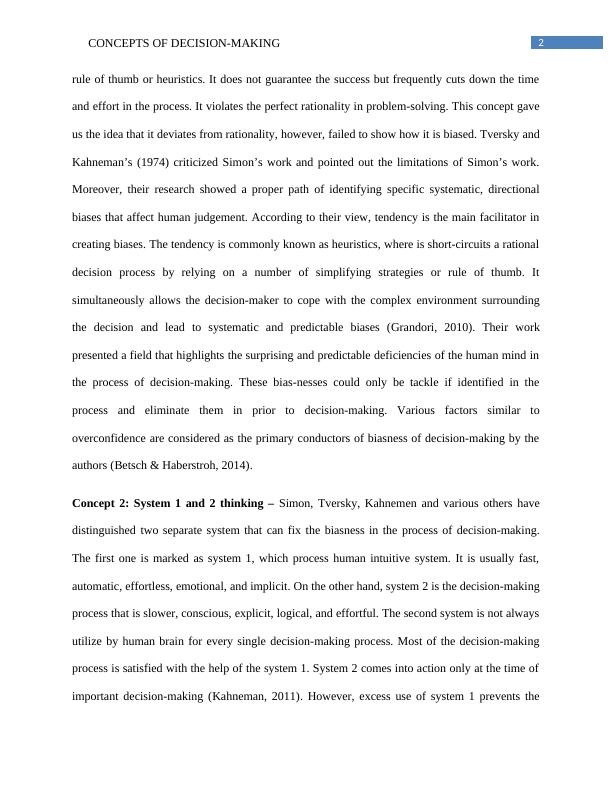Assignment Concepts of Decision Making
8 Pages2037 Words49 Views
Added on 2020-04-07
Assignment Concepts of Decision Making
Added on 2020-04-07
ShareRelated Documents
Running head: CONCEPTS OF DECISION-MAKINGConcepts of Decision-Making Part 1Name of the StudentName of the universityAuthor’s Note

1CONCEPTS OF DECISION-MAKINGPart 1IntroductionHerbert A. Simon was among the most influential social scientist of the 20th century. Hiswork on decision-making in the year 1957 was revolutionary and is still followed. Simonconsidered the organization as the structure of decision makers. According to his theory, everymember of an organization makes a decision in one way or another (Simon, 1957). However,some of the decisions that are taken by the higher authority have an impact on the lowersegments and henceforth, have more impact in the organizational settings. He incorporates threephases of the decision-making process that are intelligence activity, design activity and choiceactivity (Simon, 1959). Besides, various concepts have been proposed by Simon in his work outof which, judgment and decision-making process, system 1 and 2 thinking and boundedrationality are critically discussed in this part of the assignment. The final part of the essay iscomprised of the importance of these concepts in management decision-making.Concept 1: Judgment and decision-making process – Simon (1957) argued that the judgementand decisions are bounded by the rationality. Human being tries their best to make rationaljudgements; however, their cognitive limitations prevent them from being fully rational. Both thecost and time limits constraints the quality and quality of the information available to thedecision-makers. Besides, human is capable of retaining only a little amount of information intheir unstable memory. Simon adapted the experimental method in explaining his theory ofjudgment and decision-making process. He included psychology into the economy for theexplanation. He studied a number of participants and concluded that they hardly explore all theparts of the problem, rather take different routes to shorten the process. It is also referred as the

2CONCEPTS OF DECISION-MAKINGrule of thumb or heuristics. It does not guarantee the success but frequently cuts down the timeand effort in the process. It violates the perfect rationality in problem-solving. This concept gaveus the idea that it deviates from rationality, however, failed to show how it is biased. Tversky andKahneman’s (1974) criticized Simon’s work and pointed out the limitations of Simon’s work.Moreover, their research showed a proper path of identifying specific systematic, directionalbiases that affect human judgement. According to their view, tendency is the main facilitator increating biases. The tendency is commonly known as heuristics, where is short-circuits a rationaldecision process by relying on a number of simplifying strategies or rule of thumb. Itsimultaneously allows the decision-maker to cope with the complex environment surroundingthe decision and lead to systematic and predictable biases (Grandori, 2010). Their workpresented a field that highlights the surprising and predictable deficiencies of the human mind inthe process of decision-making. These bias-nesses could only be tackle if identified in theprocess and eliminate them in prior to decision-making. Various factors similar tooverconfidence are considered as the primary conductors of biasness of decision-making by theauthors (Betsch & Haberstroh, 2014). Concept 2: System 1 and 2 thinking – Simon, Tversky, Kahnemen and various others havedistinguished two separate system that can fix the biasness in the process of decision-making.The first one is marked as system 1, which process human intuitive system. It is usually fast,automatic, effortless, emotional, and implicit. On the other hand, system 2 is the decision-makingprocess that is slower, conscious, explicit, logical, and effortful. The second system is not alwaysutilize by human brain for every single decision-making process. Most of the decision-makingprocess is satisfied with the help of the system 1. System 2 comes into action only at the time ofimportant decision-making (Kahneman, 2011). However, excess use of system 1 prevents the

End of preview
Want to access all the pages? Upload your documents or become a member.
Related Documents
Simon’s Principle of Bounded Rationalitylg...
|14
|4339
|51
Managerial Decision Makinglg...
|12
|3720
|466
The Process of Decision Makinglg...
|16
|4316
|237
Biases of Decision Making Processlg...
|12
|2861
|272
Discrete Concepts that Explain Bias in Decision Makinglg...
|15
|4412
|109
Simon’s Theory and Decision Making Conceptslg...
|10
|2252
|98
